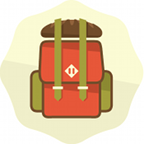When Matt and I aren’t traveling, we live in downtown Minneapolis. It’s the City of Lakes, a smaller metropolis with vibrant theater, dining, and music scenes, and currently topping a host of national polls: Fittest City, Most Bike Friendly City, Best Park System, etc. If Chicago is the brain of the midwest, our beloved city is its heart.
Minneapolis does not, however, rank as a national tourist destination. There are no national monuments to see, no tallest buildings to climb, no majestic vistas to look out on (if you don’t count lakes, forests, and farmland, which no one seems to). After all, who visits a state for its incredible education system or a preponderance of rooftop bars? Outside the Mall of America (a place no self-respecting local visits without children or out-of-town relatives in tow), there is no “reason” to come to Minneapolis. And have you heard how cold it gets here?
What this means is that European backpackers fly overhead and have no idea what they’re missing by going straight from LA to Chicago–but it also means that the few who do visit are surprised to love our city in a way no one is ever surprised to love New York.
So listen carefully when I tell you this: Ghent is the Minneapolis of Belgium.
If a local doesn’t tell you about it (the way our pal and native Belgian Daisy did for us), you’d zip right past Ghent on your way to Bruges or Brussels. Ghent is a smaller city than either of those two, with a population of about 250,000. It’s an entirely walkable city, though it has a logical and hassle-free public transit system, full of flower-lined canals and cobblestoned streets, imposing churches and more chocolateries than you could visit in a month. A perfect afternoon can be spent drinking potent Belgian beer in one of the many town squares, perhaps the one in the shadow of the city’s castle.
There is, of course, nothing to do in Ghent. You could, I suppose, take a boat cruise through the canals (for a fraction of the cost of doing this in Amsterdam or Bruges) or visit all six local cathedrals, but there are no “must dos” in this charming town. Unlike visiting London, no one will ask you, upon returning home, whether you visited Big Ben, rode the London Eye, or shopped at Portobello Road. Instead, people will probably ask, “Where’s Ghent?”
Helping us make the most of our brief three-day stay in Ghent were our AirBnB host Sas and one of her friends, who are some of the most generous people I believe I’ve ever met. They made sure we had everything we needed to enjoy our stay–including a map made up by local folks to tell you about their favorite hangouts. (It was on this map’s advice that we got fries from a friuttur who had been operating out of the same spot since 1858. I guarantee this place is not in any official guidebook, which is a crime.) They took us to the Lokerse Feesten music festival in a nearby town where we all had way too much champagne (complete with strawberries because that is, apparently, how they roll in this part of Belgium) and then to a local festival called Oudberg Fest the next night. This festival was held in the charmingly named “Father’s/Priest’s Butt” neighborhood.)
Sas gave us a tour of the town and taught us about the rebellious character of the Ghent people and the history that shaped them (there was a delightful story about Charlemagne). They shared with us more Belgian beer than I can, perhaps literally, account for and we got treated us to a meal at a very cool local restaurant (De Centrale), where one of Sas’s friends is chef. (In my favorite daydreams, I can still taste the vichyssoise–which is a sentence I have never had occasion to utter before. Thank you, Elias, for that particular gift.) And my dear Belgian friend Andromeda, whom I met while we were both au pairs in Ireland, came into town to visit and she and her fella pointed out precisely what to buy at Leonidas chocolate shop (white chocolate pralines–a delicious choice).
None of these things we did, not a single one, would be included on any official List of Things To Do in Belgium. To complete that list, you’d probably have to go to Disneyland Bruges with all the other tourists, where the man scooping gelato from a cart is wearing a chef’s hat (why? does scooping pre-made gelato make quite a mess?) and the line to ride a horse-drawn carriage circles the block. And all of that is fine and has its time and place; we get into line with everyone else when it’s called for, but there’s something wonderful about visiting a place that doesn’t have lines, that doesn’t come with a checklist, that doesn’t require the advance purchase of tickets. Because if your city visit isn’t pre-packaged, what choice do you have but to live as the locals do?
There’s no part of town the locals avoid due to buskers and peddlers and tourist hordes, so there’s no physical separation between the people who live in this city and the people who visit it. There’s no list of things to accomplish, no museum hours to fit into your schedule, no real obligations. And so you wander the winding streets with a beer in your hand and look up at buildings that look as they did 300 years ago. You drink the local drink, eat the local food, hear the local music, and leave your map in your bag because it doesn’t matter how long it takes you to get anywhere.
If you’re lucky, you’ll make a new friend or two. If you’re luckier, you’ll feel complete in a way you hadn’t expected, and it’ll feel, maybe just a little bit, like a home away from home.



